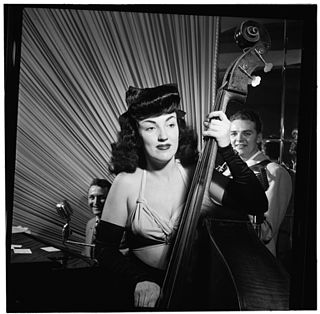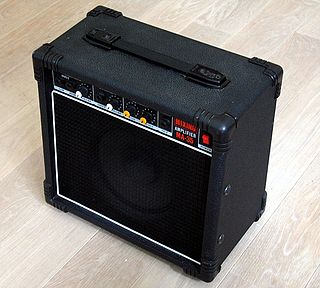Related Research Articles

Bass ( BAYSS) (also called bottom end) describes tones of low (also called "deep") frequency, pitch and range from 16 to 256 Hz (C0 to middle C4) and bass instruments that produce tones in the low-pitched range C2-C4. They belong to different families of instruments and can cover a wide range of musical roles. Since producing low pitches usually requires a long air column or string, and for stringed instruments, a large hollow body, the string and wind bass instruments are usually the largest instruments in their families or instrument classes.

Drag racing is a type of motor racing in which automobiles or motorcycles compete, usually two at a time, to be first to cross a set finish line. The race follows a short, straight course from a standing start over a measured distance, most commonly 1⁄4 mi, with a shorter, 1,000 ft distance becoming increasingly popular, as it has become the standard for Top Fuel dragsters and Funny Cars, where some major bracket races and other sanctioning bodies have adopted it as the standard. The 1⁄8 mi is also popular in some circles. Electronic timing and speed sensing systems have been used to record race results since the 1960s.
The decibel is a relative unit of measurement equal to one tenth of a bel (B). It expresses the ratio of two values of a power or root-power quantity on a logarithmic scale. Two signals whose levels differ by one decibel have a power ratio of 101/10 or root-power ratio of 101⁄20.

A weighting filter is used to emphasize or suppress some aspects of a phenomenon compared to others, for measurement or other purposes.

A subwoofer is a loudspeaker designed to reproduce low-pitched audio frequencies known as bass and sub-bass, lower in frequency than those which can be (optimally) generated by a woofer. The typical frequency range for a subwoofer is about 20–200 Hz for consumer products, below 100 Hz for professional live sound, and below 80 Hz in THX-certified systems. Thus one or more subwoofers are important for high quality sound reproduction as they are responsible for the lowest two to three octaves of the ten that are audible. This very low-frequency (VLF) range reproduces the natural fundamental tones of the bass drum, electric bass, double bass viol, cello, grand piano, contra bassoon, tuba, and organ, in addition to thunder and explosions.

A loudspeaker is an electroacoustic transducer that converts an electrical audio signal into a corresponding sound. A speaker system, also often simply referred to as a "speaker" or "loudspeaker", comprises one or more such speaker drivers, an enclosure, and electrical connections possibly including a crossover network. The speaker driver can be viewed as a linear motor attached to a diaphragm which couples that motor's movement to motion of air, that is, sound. An audio signal, typically from a microphone, recording, or radio broadcast, is amplified electronically to a power level capable of driving that motor in order to reproduce the sound corresponding to the original unamplified electronic signal. This is thus the opposite function to the microphone; indeed the dynamic speaker driver, by far the most common type, is a linear motor in the same basic configuration as the dynamic microphone which uses such a motor in reverse, as a generator.

Vehicle audio is equipment installed in a car or other vehicle to provide in-car entertainment and information for the vehicle occupants. Until the 1950s it consisted of a simple AM radio. Additions since then have included FM radio (1952), 8-track tape players, cassette players, record players, CD players (1984), DVD players, Blu-ray players, navigation systems, Bluetooth telephone integration, and smartphone controllers like CarPlay and Android Auto. Once controlled from the dashboard with a few buttons, they can now be controlled by steering wheel controls and voice commands.
A woofer or bass speaker is a technical term for a loudspeaker driver designed to produce low frequency sounds, typically from 50 Hz up to 1000 Hz. The name is from the onomatopoeic English word for a dog's bark, "woof". The most common design for a woofer is the electrodynamic driver, which typically uses a stiff paper cone, driven by a voice coil surrounded by a magnetic field.

Infrasound, sometimes referred to as low frequency sound, describes sound waves with a frequency below the lower limit of human audibility. Hearing becomes gradually less sensitive as frequency decreases, so for humans to perceive infrasound, the sound pressure must be sufficiently high. The ear is the primary organ for sensing low sound, but at higher intensities it is possible to feel infrasound vibrations in various parts of the body.

The phon is a logarithmic unit of loudness level for tones and complex sounds. Loudness is measured in sone which is a linear unit. Human sensitivity to sound is variable across different frequencies; therefore, although two different tones may present an identical sound pressure to a human ear, they may be psychoacoustically perceived as differing in loudness. The purpose of the phon is to provide a logarithmic measurement for perceived sound magnitude, while the primary loudness standard methods result in a linear representation. A sound with a loudness of 1 sone is judged equally loud as a 1 kHz tone with a sound pressure level of 40 decibels above 20 micropascal. The phon is psychophysically matched to a reference frequency of 1 kHz. In other words, the phon matches the sound pressure level (SPL) in decibels of a similarly perceived 1 kHz pure tone. For instance, if a sound is perceived to be equal in intensity to a 1 kHz tone with an SPL of 50 dB, then it has a loudness of 50 phons, regardless of its physical properties. The phon was proposed in DIN 45631 and ISO 532 B by Stanley Smith Stevens.
Audio power is the electrical power transferred from an audio amplifier to a loudspeaker, measured in watts. The electrical power delivered to the loudspeaker, together with its efficiency, determines the sound power generated.
The brown note, also sometimes called the brown frequency or brown noise, is a hypothetical infrasonic frequency capable of causing fecal incontinence by creating acoustic resonance in the human bowel. Considered an urban myth, the name is a metonym for the common color of human faeces. Attempts to demonstrate the existence of a "brown note" using sound waves transmitted through the air have failed.

Street racing is typically an unsanctioned and illegal form of auto racing that occurs on a public road. Racing in the streets is considered an ancient hazard, as horse racing occurred on streets for centuries, and street racing in automobiles is likely as old as the automobile itself. It became especially prevalent during the heyday of hot rodding (60s), muscle cars (70s), Japanese imports (90s), and sports cars (2000s). Since then, it continues to be both popular and hazardous, with deaths of bystanders, passengers, and drivers occurring every year. In the United States, modern street racing traces its roots back to Woodward Avenue, Michigan, in the 1960s when the three main Detroit-based American car companies were producing high-powered performance cars. Since a private racing venue was not always available, street races would be held illegally on public roads.

Sub-bass sounds are the deep, low-register pitches below approximately 70 Hz (C♯2 in scientific pitch notation) and extending downward to include the lowest frequency humans can hear, approximately 20 Hz (E0).

A gravity racer or soapbox is a motorless vehicle which is raced on a downhill road either against the clock or against another competitor. Although most are built for the purpose of recreation, some gravity racing teams take the sport more seriously and compete to win. They are propelled by gravity and can achieve speeds upwards of 164 km/h.
Cerwin-VegaInc. is a brand name used on products for professional audio components, as well as home audio speakers, and car audio components. Originally a stand-alone company, Cerwin-Vega was acquired by the Stanton Group after declaring bankruptcy in 2003. Then, in 2007 Stanton sold off the mobile products division to CVM Acquisition Services LLC.
A rotary woofer is a subwoofer-style loudspeaker which reproduces very low frequency content by using a conventional speaker voice coil's motion to change the pitch of an impeller rotating at a constant speed. The pitch of the fan blades is controlled by the audio signal presented to the voice coil, and is able to swing both positive and negative, with respect to a zero pitch spinning blade position. Since the audio amplifier only changes the pitch of the blades, it takes much less power, per dB of generated acoustic sound level, to drive a rotary woofer than to power a conventional subwoofer, which uses a moving electromagnet placed within the field of a stationary permanent magnet to drive a cone which then displaces air. Rotary woofers excel at producing sounds below 20 Hz, below the normal hearing range; when installed in the wall of a sealed room, they can produce audio frequencies down to 0 Hz, a static pressure differential, by simply compressing the air in the sealed room.
Bass Mekanik is a Miami bass DJ first released in 1994 on Pandisc Records. Bass Mekanik has been active for over two decades, producing 10 studio albums, 3 singles, and a DVD. He then started his own record label in 2009 called Bass Mekanik Records and produced an album called 808.

A keyboard amplifier is a powered electronic amplifier and loudspeaker in a wooden speaker cabinet used for amplification of electronic keyboard instruments. Keyboard amplifiers are distinct from other types of amplification systems such as guitar amplifiers due to the particular challenges associated with making keyboards sound louder on stage; namely, to provide solid low-frequency sound reproduction for the deep basslines which keyboards can play and crisp high-frequency sound for the high-register notes. Another difference between keyboard amplifiers and guitar/bass amplifiers is that keyboard amps are usually designed with a relatively flat frequency response and low distortion. In contrast, many guitar and bass amp designers purposely make their amplifiers modify the frequency response, typically to "roll off" very high frequencies, and most rock and blues guitar amps, and since the 1980s and 1990s, even many bass amps are designed to add distortion or overdrive to the instrument tone.
Thomas J. Danley is an American audio engineer, electrical engineer and inventor, the holder of multiple patents for audio transducers, especially high-linearity, high-output professional horn loudspeaker systems. Danley first gained notice in the 1980s with his novel servomotor-driven subwoofer systems used to reproduce very low frequencies in concert tours and theme parks. In 2000 he advanced the implementation of multiple-entry horns in 2000 with several designs led by the SPL-td1, a seven-driver loudspeaker. In 2005, he started a new company, Danley Sound Labs, through which he patented further technologies and produced a wide variety of loudspeaker models based on these technologies.
References
- ↑ Zeitung, Mitteldeutsche. "DB Drag und Bass Race: Wer hat das lauteste Gefährt?". Mitteldeutsche Zeitung (in German). Retrieved 2016-10-21.
- ↑ Germany, SPIEGEL ONLINE, Hamburg. "Dezibel Drag Racing: Die Bassmonster von Osnabrück". SPIEGEL ONLINE (in German). Retrieved 2016-10-21.
- ↑ Maynard, Micheline (Sep 5, 2003). "DRIVING; Loud, Not Fast, Wins These Races". The New York Times. Retrieved 1 December 2011.
- ↑ Wilkinson, Stephan (Jul 2003). "A Car Stereo That Can Kill You? Cool". Popular Science. Retrieved 27 December 2011.
- ↑ This American Life radio broadcast ("Auto Show"). Originally aired December 10, 2004